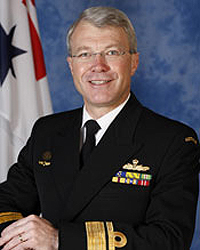Rear Admiral Steve Gilmore

Steve Gilmore joined the Royal Australian Navy as a junior entry Cadet Midshipman in 1977. After receiving his full Bridge Watchkeeping Certificate in 1983, he was posted as an officer of the watch in the then RAN Flagship, HMAS Stalwart. This was followed by service as the executive officer of the Cairns-based patrol boat HMAS Townsville in 1985-86.
On completion of the Principal Warfare Officers' course and sub-specialist training in gunnery and air warfare, Lieutenant Gilmore completed three consecutive postings at sea as PWO(A)/operations officer in both Australian and British warships. From 1992-94, he was the Fleet Gunnery Officer and in the Sea Training Group. He was subsequently posted as the Executive Officer of the guided missile frigate HMAS Melbourne in 1994-96.
Promoted Commander in 1996, he was appointed the RAN Liaison Officer to the US Navy Doctrine Command in Norfolk, Virginia. On return to Australia, Commander Gilmore was posted to Maritime Headquarters as Commander Plans (N51) during 1998-99. This most challenging and rewarding position involved the planning for all ADF and RAN operations and exercises involving major fleet units. He was awarded the Conspicuous Service Cross (CSC) in the 2000 Queen's Birthday Honours List for his service in this role.
Commander Gilmore assumed command of the Anzac Class frigate HMAS Arunta in 2000. In addition to major task group deployments, a highlight of this period was the award of the prestigious Duke of Gloucester's Cup, which recognised Arunta as the Navy's best major fleet unit in 2000.
Promoted Captain in 2001, he attended the Defence and Strategic Studies Course at the Australian Defence College during 2002 and graduated with a Master of Arts degree in Strategic Studies. Captain Gilmore was appointed as the Director of Maritime Combat Development in the Capability Systems Division of Australian Defence Headquarters in December 2002. In this capacity he was responsible for the development of capability requirements documentation relating to the eventual acquisition of future ship's and combat systems for the Royal Australian Navy.
Captain Gilmore was promoted Commodore in January 2005 and appointed to the position of Director General Navy Strategic Policy and Futures (DGNSPF) in Navy Headquarters. Selected to command coalition Task Force 58 in the Northern Persian Gulf, Commodore Gilmore was deployed as part of Operation CATALYST between April and August 2005. With a small RAN staff, Commodore Gilmore embarked in the cruisers USS Antietam and USS Normandy and was responsible for the conduct of all maritime security operations. He returned to the DGNSPF position in September 2005. Commodore Gilmore was appointed a Member of the Order of Australia (AM) in the 2006 Queens Birthday honours list in recognition of his service as Commander Task Force 58.
Commodore Gilmore became the Commander of Navy Systems Command in September 2007 and was promoted Rear Admiral in June 2008. In this role he commanded all Navy shore commands and was responsible for personnel posting and individual training, workplace health and safety, engineering policy and Navy communications/electronic warfare.
After a short period in the new position of Head Navy People and Reputation within Navy Strategic Command, Rear Admiral Gilmore was appointed as Commander Australian Fleet from October 2009 to December 2011. This role included responsibility for Navy capability generation and war-fighting standards across all RAN submarines, surface ships and aircraft.
Rear Admiral Gilmore served as the Deputy Chief of Joint Operations at Headquarters Joint Operations Command near Canberra from December 2011 to November 2013. He assumed the position as the Head Australian Defence Staff (Washington) and Australian Defence Attaché at the Embassy of Australia, Washington DC, in January 2014. Rear Admiral Gilmore retired from the RAN in 2017.


